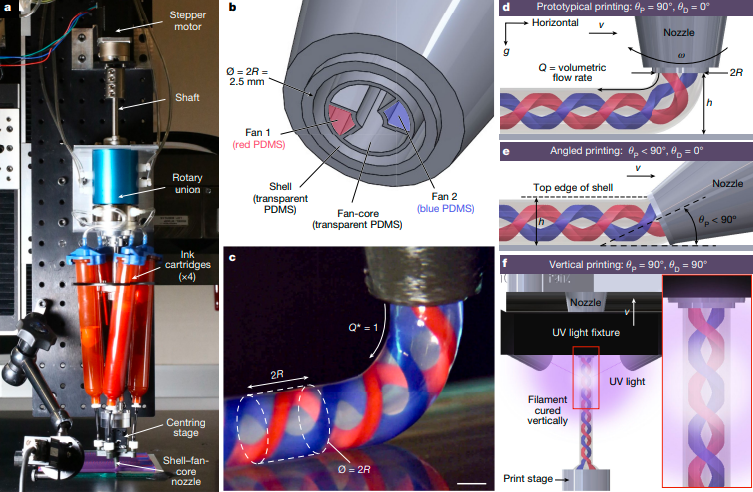Abstract
Helical structures are ubiquitous in nature and impart unique mechanical properties and multifunctionality. So far, synthetic architectures that mimic these natural systems have been fabricated by winding, twisting and braiding of individual filaments, microfluidics, self-shaping and printing methods. However, those fabrication methods are unable to simultaneously create and pattern multimaterial, helically architected filaments with subvoxel control in arbitrary two-dimensional (2D) and three-dimensional (3D) motifs from a broad range of materials. Towards this goal, both multimaterial and rotational 3D printing of architected filaments have recently been reported; however, the integration of these two capabilities has yet to be realized. Here we report a rotational multimaterial 3D printing (RM-3DP) platform that enables subvoxel control over the local orientation of azimuthally heterogeneous architected filaments. By continuously rotating a multimaterial nozzle with a controlled ratio of angular-to-translational velocity, we have created helical filaments with programmable helix angle, layer thickness and interfacial area between several materials within a given cylindrical voxel. Using this integrated method, we have fabricated functional artificial muscles composed of helical dielectric elastomer actuators with high fidelity and individually addressable conductive helical channels embedded within a dielectric elastomer matrix. We have also fabricated hierarchical lattices comprising architected helical struts containing stiff springs within a compliant matrix. Our additive-manufacturing platform opens new avenues to generating multifunctional architected matter in bioinspired motifs.


This work was contributed by Natalie M. Larson1,2, Jochen Mueller1,2, Alex Chortos1,2, Zoey S. Davidson1,2, David R. Clarke1
&
Jennifer A. Lewis1,2
1
Harvard John A. Paulson School of Engineering and Applied Sciences, Harvard University, Cambridge, MA, USA.
2
Wyss Institute for Biologically Inspired Engineering, Harvard University,
Cambridge, MA, USA.
and published on Nature volume 613, pages 682–688 (2023) https://doi.org/10.1038/s41586-022-05490-7
Copyright © 2024 International Society of Bionic Engineering All Rights Reserved
吉ICP备11002416号-1









